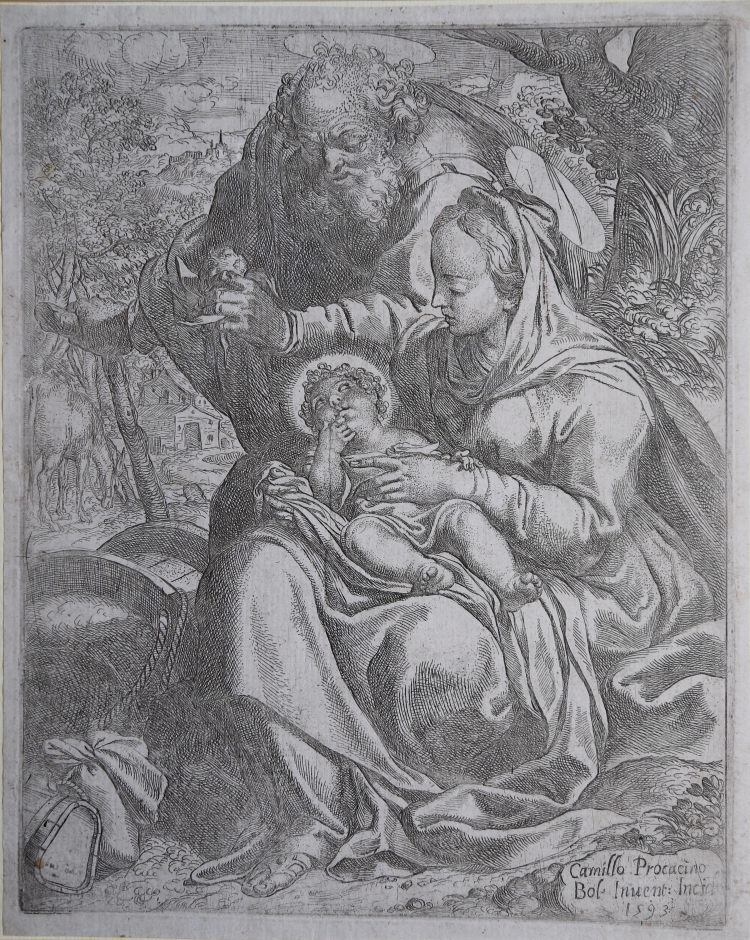




| Reference: | S30750 |
| Author | Camillo PROCACCINI |
| Year: | 1593 |
| Measures: | 209 x 262 mm |



| Reference: | S30750 |
| Author | Camillo PROCACCINI |
| Year: | 1593 |
| Measures: | 209 x 262 mm |
Etching, 1593, dated and signed on plate at bottom right.
A good impression, printed on contemporary laid paper, with small margins, very good condition.
When Procaccini engraved this plate, in 1593 according to the date shown on the bottom right, he had just arrived in Milan, so the artist recalls his hometown in the signature: Bol bolognese.
This etching represents the artist’s third version of the Rest. The motif is based on Matthew 2:13-15 I which Joseph, warned in a dream of Herod’s murderous search for the prophesied King of the Jews, talking “the child and his mother with him, left that night for Egypt”.
Landscape is often an important feature in images of the Rest, but in this etching the massive figures fill the scene almost entirely. The haloed child reclines in Mary’s lap, looking upward toward Joseph who looms over them, animating the scene as he leans forward with a citron in his hand. Forming sort of a protective cave for the baby Jesus, Mary and Joseph are each encased in a bulky carapace of draperies composed of a thick network of cross-hatching complemented by shorter strokes and a system of dots that modulate the chiaroscuro and suggest homespun textures. Their faces are lit by an iridescence that seems to radiate from the child on whom they gaze with awed expressions.
The work is among his most famous creations.
|
TIB, 39, p. 101 n.5; Bartsch, XVIII, p. 19 n. 2.
|
Camillo PROCACCINI (Bologna 1551 circa – Milano 1629)
|
Painter, printmaker and draughtsman, son of Ercole Procaccini. He was first mentioned in 1571 as a student in the Bolognese painters’ guild when his father, Ercole, was its head. This, and the stylistic maturity of his earliest surviving documented works, the frescoes (1585–7) in St Prospero, Reggio Emilia, suggest his date of birth. Trained by his father, he went to Rome c. 1580 with Conte Pirro Visconti, an important Milanese collector. His studies in Rome, particularly of the art of Taddeo Zuccaro, clearly affected his work after his return to Bologna. In 1582 he decorated the side walls of the apse of St Clemente, Collegio di Spagna, Bologna, and these frescoes (partially photographed before their destruction in 1914) seem to have been an energetic reflection of the exaggerated forms and contrasts of scale typical of mid-16th-century central Italian painting
|
|
TIB, 39, p. 101 n.5; Bartsch, XVIII, p. 19 n. 2.
|
Camillo PROCACCINI (Bologna 1551 circa – Milano 1629)
|
Painter, printmaker and draughtsman, son of Ercole Procaccini. He was first mentioned in 1571 as a student in the Bolognese painters’ guild when his father, Ercole, was its head. This, and the stylistic maturity of his earliest surviving documented works, the frescoes (1585–7) in St Prospero, Reggio Emilia, suggest his date of birth. Trained by his father, he went to Rome c. 1580 with Conte Pirro Visconti, an important Milanese collector. His studies in Rome, particularly of the art of Taddeo Zuccaro, clearly affected his work after his return to Bologna. In 1582 he decorated the side walls of the apse of St Clemente, Collegio di Spagna, Bologna, and these frescoes (partially photographed before their destruction in 1914) seem to have been an energetic reflection of the exaggerated forms and contrasts of scale typical of mid-16th-century central Italian painting
|